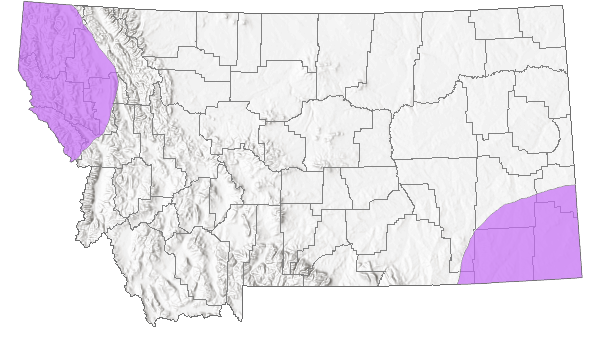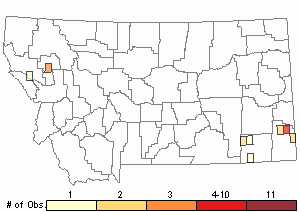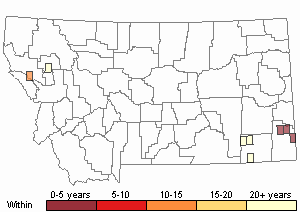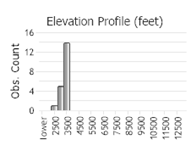View in other NatureServe Network Field Guides
NatureServe
Montana
Utah
Wyoming
Idaho
Wisconsin
British Columbia
South Carolina
Yukon
California
New York
Scribner's Panic Grass - Dichanthelium oligosanthes var. scribnerianum
Other Names:
Panicum oligosanthes var. scribnerianum, Panicum scribnerianum
State Rank Reason (see State Rank above)
Scribner's panic grass is a plant of dry woodlands, known from widely separated sites in southeastern and northwestern Montana. Only one large-sized population is known in the state, two others are very small, and the fourth occurrence is known only from a historical collection. Occurrences in eastern Montana may be negatively impacted by cattle grazing. The largest occurrence in the state lies adjacent to Highway 93 and negative impacts associated with expansion of the highway is likely. Invasive weeds and forest encroachment are also problems at this site.
General Description
Scribner's Panic Grass is a perennial which forms clumps of simple or branched stems that are 1-6 dm tall. The lower leaves are 3-10 cm long and 3-12 mm wide, while the upper leaves are short and relatively broad. Leaves are mostly glabrous, but the sheaths surrounding the stem are glabrous to long-hairy. There is a short fringe of hairs on the leaf where it meets the stem, which is known as a ligule. The flowers are borne on short to long stalks, which are arranged in a conical inflorescence that is 3-8 cm high. Inflorescences of the main stems are larger than those of the branches. Each egg-shaped spikelet has one flower, is ca. 3 mm long, and consists of two glumes enclosing a lemma and a palea that may or may not be hairy.
Phenology
Spikelets mature in late June and early July.
Diagnostic Characteristics
Dichanthelium has been segregated from
Panicum. Montana has 3 species of
Dichanthelium. Members of
Dichanthelium:
* Develop a rosette of short, broad basal leaves during the cool season, while
Panicum species do not.
* Grow during the cool and warm seasons, whereas,
Panicum species grow in the warm season.
* Produce cleistogamous (self-pollinating) florets, which are often found on small axillary inflorescences during the late summer to fall.
Scribner’s Panic Grass –
Dichanthelium oligosanthes var.
scribnerianum, native, SOC
* Stems 20-50 cm tall.
* Spikelets 2-5 mm long.
* Upper leaf surface is glabrous. Lower leaf surface is hairy.
* Ligules 1-3 mm tall.
* Disturbed sites and open understory in northwest and southeast Montana.
Wilcox’s Panic Grass –
Dichanthelium wilcoxianum, native
* Stems 10-20 cm tall.
* Spikelets less than 2.5 mm long.
* Upper and lower leaf surfaces hairy.
* Ligules 1.0 mm or less tall.
* Grasslands and open Ponderosa Pine forests in eastern Montana.
Panic Grass –
Dichanthelium acuminatum subsp.
sericeum, native, SOC
* Stems 10-30 cm tall.
* Spikelets 1.5-2.5 mm long.
* At maturity the larger second glume is often purplish.
* Upper and lower leaf surfaces hairy.
* Ligules 2-6 tall.
*
Often in wet soils around hot springs.
Switchgrass (
Pancium virgatum) is a rhizomatous, perennial grass while Montana's other
Panicum species are annuals.
Species Range
Montana Range
Range Descriptions

 Native
Native
Range Comments
Ont. to B.C., south throughout most of the U.S. and n. Mex. Sparse.
Observations in Montana Natural Heritage Program Database
Number of Observations: 27
(Click on the following maps and charts to see full sized version)
Map Help and Descriptions
Relative Density

Recency



 (Observations spanning multiple months or years are excluded from time charts)
(Observations spanning multiple months or years are excluded from time charts)
Habitat
This plant has been documented from southeast and northwest Montana. In Lake County it was collected in sandy pinelands. Two small colonies recently documented in Powder River County occupied Pinus ponderosa/Mahonia repens habitat. Both were at the upper end of draws, with one on the lower south-facing slope of a steep, wooded drainage and the other at the gently sloping upper end near the border between woodland and grassland. Associated species included Agropyron spicatum, Astragalus agrestis, Astragalus americanus, Carex deweyana, Carex sprengelii, Crepis acuminata, Elymus glaucus, Euphorbia glyptosperma, Penstemon gracilis and Poa pratensis. Soils were well-drained, coarse, sandy or gravelly loams.
National Vegetation Classification System Groups Associated with this Species
Forest and Woodland
Deciduous Forest and Woodland
Low Elevation - Xeric Forest and Woodland
Grassland
Lowland - Prairie Grassland
Ecology
Scribner's panic grass is a perennial that reproduces strictly by seed. Both vernal (early season) inflorescences and autumnal (late season) inflorescences are produced. The species survives fire, but impacts on population size are unknown. In one locality that had burned, plants emerged earlier and had more stems than those at a nearby unburned site. This species does not exhibit marked population increases in the wake of fire, as does Wilcox' panic grass (Heidel and Dueholm 1995).
Management
Areas of Lake County where this grass occurs are being invaded by knapweed species. Many wooded draws in southeastern Montana are being invaded by leafy spurge. This panic grass is thought to decrease under grazing (Smith 1976), and overgrazing could adversely affect it.
Stewardship Responsibility
Threats or Limiting Factors
STATE THREAT SCORE REASON
Reported threats to Montana's populations of Scribner's Panic Grass are those that have negative impacts to its habitat in woody draws. Livestock grazing and noxious weeds are reported to threaten populations. Information on scope and severity of these threats is needed (MTNHP Threat Assessment 2021).
References
- Literature Cited AboveLegend:
 View Online Publication
View Online Publication Flora of North America Editorial Committee. 2003. Flora of North America North of Mexico. Vol. 25. Magnoliophyta: Commelinidae (in part): Poaceae, part 2. Oxford Univ. Press, New York. xxv + 781 pp.
Flora of North America Editorial Committee. 2003. Flora of North America North of Mexico. Vol. 25. Magnoliophyta: Commelinidae (in part): Poaceae, part 2. Oxford Univ. Press, New York. xxv + 781 pp. MTNHP Threat Assessment. 2021. State Threat Score Assignment and Assessment of Reported Threats from 2006 to 2021 for State-listed Vascular Plants. Botany Program, Montana Natural Heritage Program, Helena, Montana.
MTNHP Threat Assessment. 2021. State Threat Score Assignment and Assessment of Reported Threats from 2006 to 2021 for State-listed Vascular Plants. Botany Program, Montana Natural Heritage Program, Helena, Montana.
- Additional ReferencesLegend:
 View Online Publication
View Online Publication
Do you know of a citation we're missing? Heidel, B.L. and H. Marriott. 1996. Sensitive plant species survey of the Ashland District, Custer National Forest, Powder River and Rosebud Counties, Montana. Unpublished report to the U.S. Forest Service. Montana Natural Heritage Program, Helena, Montana. 94 pp. plus appendices.
Heidel, B.L. and H. Marriott. 1996. Sensitive plant species survey of the Ashland District, Custer National Forest, Powder River and Rosebud Counties, Montana. Unpublished report to the U.S. Forest Service. Montana Natural Heritage Program, Helena, Montana. 94 pp. plus appendices. Heidel, B.L. and K.H. Dueholm. 1995. Sensitive plant survey in the Sioux District, Custer National Forest, 1994, Carter County, Montana and Harding County, South Dakota. Unpublished report to the Custer National Forest. Montana Natural Heritage Program, Helena, Montana. 95 pp. plus appendices.
Heidel, B.L. and K.H. Dueholm. 1995. Sensitive plant survey in the Sioux District, Custer National Forest, 1994, Carter County, Montana and Harding County, South Dakota. Unpublished report to the Custer National Forest. Montana Natural Heritage Program, Helena, Montana. 95 pp. plus appendices. Lesica, P., M.T. Lavin, and P.F. Stickney. 2012. Manual of Montana Vascular Plants. Fort Worth, TX: BRIT Press. viii + 771 p.
Lesica, P., M.T. Lavin, and P.F. Stickney. 2012. Manual of Montana Vascular Plants. Fort Worth, TX: BRIT Press. viii + 771 p. Lesica, P., M.T. Lavin, and P.F. Stickney. 2022. Manual of Montana Vascular Plants, Second Edition. Fort Worth, TX: BRIT Press. viii + 779 p.
Lesica, P., M.T. Lavin, and P.F. Stickney. 2022. Manual of Montana Vascular Plants, Second Edition. Fort Worth, TX: BRIT Press. viii + 779 p. McGregor, R.L. (coordinator), T.M. Barkley, R.E. Brooks, and E.K. Schofield (eds). 1986. Flora of the Great Plains: Great Plains Flora Association. Lawrence, KS: Univ. Press Kansas. 1392 pp.
McGregor, R.L. (coordinator), T.M. Barkley, R.E. Brooks, and E.K. Schofield (eds). 1986. Flora of the Great Plains: Great Plains Flora Association. Lawrence, KS: Univ. Press Kansas. 1392 pp. Smith, R. 1976. Ecological and use information for plant species of the Aberdeen and Billings areas of the Bureau of Indian Affairs. USDI Bureau of Indian Affairs, Billings, Montana. 228 pp.
Smith, R. 1976. Ecological and use information for plant species of the Aberdeen and Billings areas of the Bureau of Indian Affairs. USDI Bureau of Indian Affairs, Billings, Montana. 228 pp.
- Web Search Engines for Articles on "Scribner's Panic Grass"





